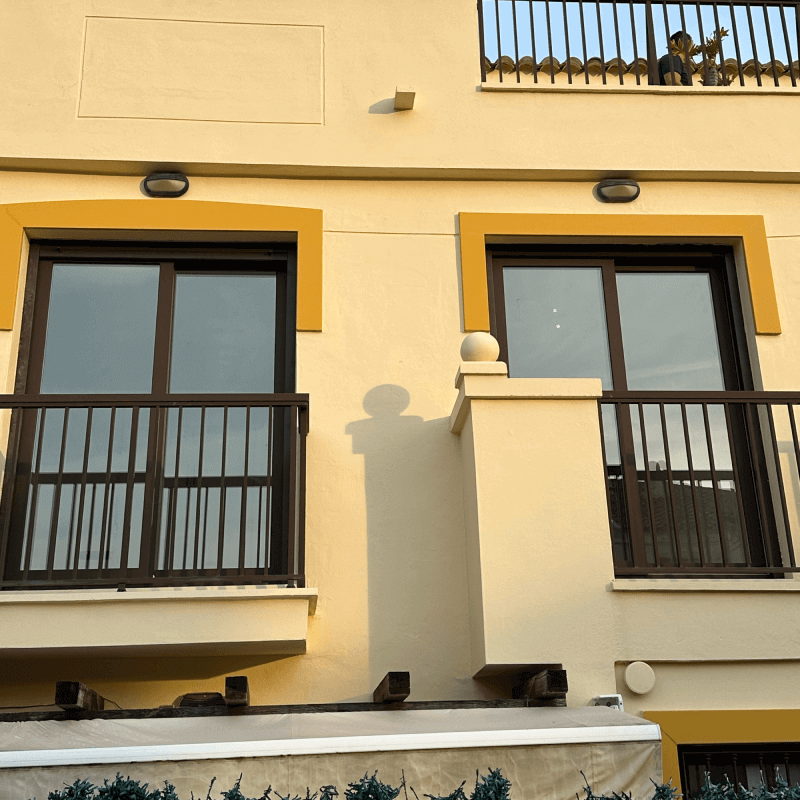Windows for different rooms: bedroom, kitchen, bathroom and other rooms
· María Fernández · General knowledge · 9 min read
A bedroom window should provide quiet and dark conditions for sleep, a kitchen window should withstand temperature fluctuations and humidity, and a bathroom window should protect privacy and prevent mold. We’ll explore the specifics of each room and calculate the cost of getting it right the first time.
Bedroom Windows – Silence and Light Control
You spend 8 hours a day in your bedroom, and the quality of your window directly impacts your sleep. Street noise is the main enemy of a good night’s sleep, especially in cities. In central Madrid or Barcelona, noise levels at night reach 55-60 dB, while comfortable sleep requires no more than 30 dB.
Window soundproofing depends more on the glass unit than on the frame. A standard double-glazed unit reduces noise by 30-32 dB. However, using panes of varying thickness (e.g., 4-6-4 mm) and varying spacing improves soundproofing to 35-40 dB. Special acoustic double-glazed windows with laminated glass and an enlarged air chamber reduce noise up to 45 dB, allowing only mild background noise from the street.
Micro-ventilation is especially important in the bedroom. A gap of a few millimeters ensures a fresh air supply without creating a draft and cooling the room. Micro-ventilation fittings add €30-50 to the cost of the window, but it’s the best investment in a healthy sleep.
Light control requires a comprehensive approach. A window alone doesn’t block light; additional solutions are needed. Blinds integrated into the double-glazed window are an elegant option for an additional €200-300. They sit between the panes, are dust-resistant, and are controlled by a magnetic handle or motor.
Roller shutters provide 100% blackout and additional sound insulation. In Spanish bedrooms, they’ve become standard—closed roller shutters reduce the room temperature by 3-5 degrees in summer and create complete darkness even during the day. Manual roller shutters cost from €150 per square meter, while automatic shutters start at €300.
Window placement in the bedroom affects the microclimate. East-facing windows provide morning sun—a natural alarm clock—but in summer, the room heats up by 9 a.m. West-facing windows mean afternoon heat and difficulty falling asleep in summer. North-facing windows provide even light without overheating, but the room can be cool in winter.
Children’s bedroom security requires special solutions. Handles with a key or button cost €20-30 but ensure that the child doesn’t open the window on their own. Opening limiters, €15-20, allow ventilation but prevent the window from opening fully.
Kitchen Windows—Practicality Above All
The kitchen is the room in the house most vulnerable to window damage. Cooking steam, grease splashes, temperature fluctuations, and constant opening for ventilation all require particularly durable and practical solutions.
The frame material is more important in the kitchen than in other rooms. PVC is ideal—it doesn’t absorb odors or grease, is easy to clean, and is moisture-resistant. Wooden windows in the kitchen require constant maintenance and can swell from steam. Aluminum is good, but condensation will form on cold profiles.
If the window is located above the countertop or sink, casement windows are inconvenient—they get in the way and can hit you in the head. Sliding systems or windows with a lift-and-lift sash, which opens like a garage door, are more suitable here. These systems are 40-50% more expensive than standard ones, but the convenience is worth it.
The splashback between the countertop and the window is an area of special attention. The standard height is 60 cm, but if the window is low, you’ll either have to lower the countertop or install a narrow splashback. It’s important to ensure a tight seal between the splashback and the window, otherwise water will leak in and dirt will accumulate.
Ventilation in the kitchen is critical. Cooking produces a lot of moisture—up to 2-3 liters of water vapor per day. Without proper ventilation, condensation will constantly form on the windows, and mold will develop on the slopes. Intake vents in windows work in tandem with the range hood, ensuring constant air exchange.
A kitchen window sill is often used as an additional work surface. Plastic window sills are unsuitable for this purpose—they scratch and dent when exposed to heat. It’s better to choose a window sill made of artificial stone (from €150 per linear meter) or natural granite (from €200). Such a window sill can be integrated with the countertop, creating a unified surface.
Mosquito nets in the kitchen should be removable for easy cleaning. Kitchen nets accumulate a greasy film, which attracts dust. Roller screens are inconvenient here—they’re more difficult to remove and clean.
Bathroom Windows—Combating Humidity
A bathroom window is both an advantage (natural light and ventilation) and a challenge (humidity, privacy, mold). In Spain, bathroom windows are found in 60% of private homes and only 20% of apartments.
Ventilation is the main function of a bathroom window. After a hot shower, the air humidity reaches 90-100%. If the moisture doesn’t escape, it condenses on the walls and windows, creating ideal conditions for mold. A tilt-and-turn ventilation system is essential—it allows steam to escape without opening the window.
Frosted or patterned glass is chosen for bathrooms to ensure privacy. Satin glass (chemically etched) costs €30-€40 per square meter more than standard glass, but it is opaque and easy to clean. Frosted film is a budget option at €20-€30 per square meter, but it can peel off over time due to moisture.
The frame material must be able to withstand constant humidity. PVC is again the leading choice—it is completely resistant to moisture. Aluminum is also suitable, but only with a thermal break, otherwise it will cause constant condensation. It’s best to avoid wood in the bathroom—even with a protective coating, it requires constant attention.
Window placement influences the ease of use of the bathroom. The window in the shower area should be at least 150 cm above the floor. If the window is lower, a waterproof curtain or screen will be needed. A window opposite the mirror creates natural light for morning routines—women especially appreciate the ability to apply makeup in daylight.
Bathroom window sills require a moisture-resistant finish. Drywall, even moisture-resistant, is a bad idea. It’s better to use plastic panels, ceramic tiles, or moisture-resistant plaster with high-quality waterproofing paint.
Bathroom windowsills are often used to store cosmetics and towels. A plastic sill will withstand moisture, but it will still show marks from the bottles. A window sill made of artificial stone is more practical—it’s moisture-resistant, scratch-resistant, and easy to clean.
Living Room Windows: A Balance of Light and Comfort
The living room is the showcase of the home, a place for entertaining guests and family relaxation. Windows here should provide maximum light, provide a good view, and yet not create discomfort from the sun or prying eyes.
Window size in the living room is usually larger than in other rooms. The optimal glazing area is 15-20% of the floor area. For a 30 sq m living room, this means 4.5-6 sq m of windows. More windows will make it difficult to control the temperature, while fewer will make the room feel dark.
Floor-to-ceiling French windows visually expand the space and blur the line between the house and the garden. However, the lower portion of these windows often gets dirty, especially if there are children or pets in the house. Tempered glass at the bottom (up to a height of 80 cm) is a mandatory safety requirement.
Energy-efficient glass in the living room pays for itself faster than in other rooms because the glass surface is larger. Low-E coating reflects radiant heat back into the room in winter and keeps the heat out in summer. The price difference is approximately €40-60 per sq m, and savings on heating and air conditioning can be up to 25%.
Opening systems in the living room are chosen based on lifestyle. If you like to host parties with access to the garden, large sliding or folding doors are a good choice. If your living room faces a noisy street, it’s best to install windows with good soundproofing and a micro-ventilation system.
Windows in the Home Office: Productivity and Health
With the rise of remote work, the right windows in your home office have begun to impact productivity and health. Poor lighting causes eye strain and headaches, while poor ventilation reduces concentration.
Window placement relative to your desk is critical. A window directly in front of your desk creates glare on your monitor on sunny days. A window behind you creates glare on your screen and a shadow cast by your figure on your desk. A window to the side of your desk is ideal, preferably facing north for even light without direct sunlight.
Adjustable sun protection is essential for a home office. Interior blinds with adjustable slats allow you to precisely adjust the amount of light. Screen roller blinds (from €80 per m²) filter light, maintaining visibility of the street and protecting against glare.
Soundproofing impacts your ability to concentrate. If your office faces the street, invest in windows with enhanced sound insulation (from 35 dB). The price difference is 20-30% compared to standard windows, but research shows that productivity in quiet spaces is 15-20% higher.
Special Spaces and Their Requirements
Wardrobes are often windowless, but if they do have a window, UV protection is important. Direct sunlight fades clothing, especially natural fabrics. Tinted glass or a UV filter are essential.
Storage rooms or utility rooms require minimal investment in windows. Simple single-pane glass and a hinged sash for ventilation are sufficient. Security (bars or vandal-resistant glass on the ground floor) is key.
Roof windows are a separate category with their own specific requirements. They provide 40% more light than vertical windows of the same area, but require high-quality installation to protect against leaks.
Basements with ground-level windows require enhanced waterproofing and drainage sumps. Windows should have micro-ventilation to combat the high humidity in basements.
Key Selection Principles
The function of the room determines the window requirements. Don’t try to install identical windows everywhere for a discount—you’ll end up overpaying for electricity or suffering from inconvenience.
Invest in quality where it’s crucial: soundproofing in the bedroom, energy efficiency in the living room, moisture resistance in the bathroom. You can save money in utility rooms.
Think long-term. A 30% premium for energy-efficient glass will pay for itself in 5-7 years. Automatic roller shutters will last 15-20 years and ensure a comfortable sleep every night.
Don’t forget about the little things that make a difference: mosquito nets, child safety stops, and windowsills of the right width. Adding these later will be more difficult and expensive.




